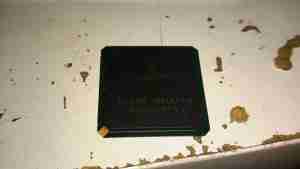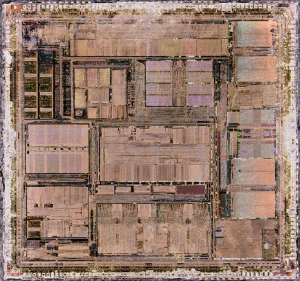
This is a System On Chip from Motorola, designed for network routing applications. This chip contains a hell of a feature set, so I’ll just include an excerpt from the datasheet:

Embedded single-issue, 32-bit MPC8xx core (implementing the PowerPC architecture) with thirty-two 32-bit general-purpose registers (GPRs) — The core performs branch prediction with conditional prefetch, without conditional execution — 4- or 8-Kbyte data cache and 4- or 16-Kbyte instruction cache (see Table 1) – 16-Kbyte instruction caches are four-way, set-associative with 256 sets; 4-Kbyte instruction caches are two-way, set-associative with 128 sets. – 8-Kbyte data caches are two-way, set-associative with 256 sets; 4-Kbyte data caches are two-way, set-associative with 128 sets. – Cache coherency for both instruction and data caches is maintained on 128-bit (4-word) cache blocks. – Caches are physically addressed, implement a least recently used (LRU) replacement algorithm, and are lockable on a cache block basis. — Instruction and data caches are two-way, set-associative, physically addressed, LRU replacement, and lockable on-line granularity. — MMUs with 32-entry TLB, fully associative instruction, and data TLBs — MMUs support multiple page sizes of 4, 16, and 512 Kbytes, and 8 Mbytes; 16 virtual address spaces and 16 protection groups — Advanced on-chip-emulation debug mode Up to 32-bit data bus (dynamic bus sizing for 8, 16, and 32 bits) 32 address lines Operates at up to 80 MHz Memory controller (eight banks) — Contains complete dynamic RAM (DRAM) controller — Each bank can be a chip select or RAS to support a DRAM bank — Up to 15 wait states programmable per memory bank — Glueless interface to DRAM, SIMMS, SRAM, EPROM, Flash EPROM, and other memory devices. — DRAM controller programmable to support most size and speed memory interfaces — Four CAS lines, four WE lines, one OE line — Boot chip-select available at reset (options for 8-, 16-, or 32-bit memory) — Variable block sizes (32 Kbyte to 256 Mbyte) — Selectable write protection — On-chip bus arbitration logic General-purpose timers — Four 16-bit timers or two 32-bit timers — Gate mode can enable/disable counting — Interrupt can be masked on reference match and event capture System integration unit (SIU) — Bus monitor — Software watchdog — Periodic interrupt timer (PIT) — Low-power stop mode — Clock synthesizer — Decrementer, time base, and real-time clock (RTC) from the PowerPC architecture — Reset controller — IEEE 1149.1 test access port (JTAG) Interrupts — Seven external interrupt request (IRQ) lines — 12 port pins with interrupt capability — 23 internal interrupt sources — Programmable priority between SCCs — Programmable highest priority request 10/100 Mbps Ethernet support, fully compliant with the IEEE 802.3u Standard (not available when using ATM over UTOPIA interface) ATM support compliant with ATM forum UNI 4.0 specification — Cell processing up to 50–70 Mbps at 50-MHz system clock — Cell multiplexing/demultiplexing — Support of AAL5 and AAL0 protocols on a per-VC basis. AAL0 support enables OAM and software implementation of other protocols). — ATM pace control (APC) scheduler, providing direct support for constant bit rate (CBR) and unspecified bit rate (UBR) and providing control mechanisms enabling software support of available bit rate (ABR) — Physical interface support for UTOPIA (10/100-Mbps is not supported with this interface) and byte-aligned serial (for example, T1/E1/ADSL) — UTOPIA-mode ATM supports level-1 master with cell-level handshake, multi-PHY (up to 4 physical layer devices), connection to 25-, 51-, or 155-Mbps framers, and UTOPIA/system clock ratios of 1/2 or 1/3. — Serial-mode ATM connection supports transmission convergence (TC) function for T1/E1/ADSL lines; cell delineation; cell payload scrambling/descrambling; automatic idle/unassigned cell insertion/stripping; header error control (HEC) generation, checking, and statistics. Communications processor module (CPM) — RISC communications processor (CP) — Communication-specific commands (for example, GRACEFUL STOP TRANSMIT , ENTER HUNT MODE , and RESTART TRANSMIT ) — Supports continuous mode transmission and reception on all serial channels — Up to 8Kbytes of dual-port RAM — 16 serial DMA (SDMA) channels — Three parallel I/O registers with open-drain capability Four baud-rate generators (BRGs) — Independent (can be connected to any SCC or SMC) — Allow changes during operation — Autobaud support option Four serial communications controllers (SCCs) — Ethernet/IEEE 802.3 optional on SCC1–4, supporting full 10-Mbps operation (available only on specially programmed devices). — HDLC/SDLC (all channels supported at 2 Mbps) — HDLC bus (implements an HDLC-based local area network (LAN)) — Asynchronous HDLC to support PPP (point-to-point protocol) — AppleTalk — Universal asynchronous receiver transmitter (UART) — Synchronous UART — Serial infrared (IrDA) — Binary synchronous communication (BISYNC) — Totally transparent (bit streams) — Totally transparent (frame based with optional cyclic redundancy check (CRC)) Two SMCs (serial management channels) — UART — Transparent — General circuit interface (GCI) controller — Can be connected to the time-division multiplexed (TDM) channels One SPI (serial peripheral interface) — Supports master and slave modes — Supports multimaster operation on the same bus One I 2 C (inter-integrated circuit) port — Supports master and slave modes — Multiple-master environment support Time-slot assigner (TSA) — Allows SCCs and SMCs to run in multiplexed and/or non-multiplexed operation — Supports T1, CEPT, PCM highway, ISDN basic rate, ISDN primary rate, user defined — 1- or 8-bit resolution — Allows independent transmit and receive routing, frame synchronization, clocking — Allows dynamic changes — Can be internally connected to six serial channels (four SCCs and two SMCs) Parallel interface port (PIP) — Centronics interface support — Supports fast connection between compatible ports on the MPC860 or the MC68360 PCMCIA interface — Master (socket) interface, release 2.1 compliant — Supports two independent PCMCIA sockets — Eight memory or I/O windows supported Low power support — Full on—all units fully powered — Doze—core functional units disabled, except time base decrementer, PLL, memory controller, RTC, and CPM in low-power standby — Sleep—all units disabled, except RTC and PIT, PLL active for fast wake up — Deep sleep—all units disabled including PLL, except RTC and PIT — Power down mode— all units powered down, except PLL, RTC, PIT, time base, and decrementer Debug interface — Eight comparators: four operate on instruction address, two operate on data address, and two operate on data — Supports conditions: = ≠ < > — Each watchpoint can generate a break-point internally 3.3 V operation with 5-V TTL compatibility except EXTAL and EXTCLK 357-pin ball grid array (BGA) package
